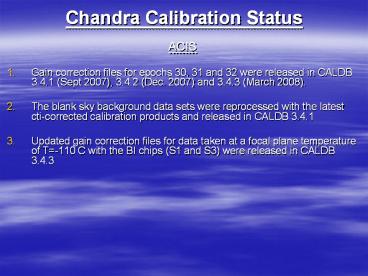Chandra Calibration Status - PowerPoint PPT Presentation
1 / 21
Title:
Chandra Calibration Status
Description:
The blank sky background data sets were reprocessed with the latest cti ... present, CC mode observations do not telemeter grade 7 events, so a separate QE ... – PowerPoint PPT presentation
Number of Views:44
Avg rating:3.0/5.0
Title: Chandra Calibration Status
1
Chandra Calibration Status
- ACIS
- Gain correction files for epochs 30, 31 and 32
were released in CALDB 3.4.1 (Sept 2007), 3.4.2
(Dec. 2007) and 3.4.3 (March 2008). - The blank sky background data sets were
reprocessed with the latest cti-corrected
calibration products and released in CALDB 3.4.1 - Updated gain correction files for data taken at a
focal plane temperature of T-110 C with the BI
chips (S1 and S3) were released in CALDB 3.4.3
2
HRC
- An updated HRC-I de-gap corrections table derived
from the AO8 Capella raster scan was released in
CALDB 3.4.1. This improves image reconstruction
for off-axis sources.
Web Pages
1. A tag index of all presentations given at the
Chandra calibration workshops is now on-line at
cxc.harvard.edu/ccw/tags
3
ACIS and HETG Calibration Projects
Develop a set of cti-corrected calibration
products
for CC-mode observations.
ACIS Flight Grades
4
Comparison of TE and CC mode grade distributions
5
Comparison between ECS data taken in TE and CC
mode
6
Comparison between Mn-K line profile in TE and CC
mode
7
Future work on CC mode calibration
1. The CC mode cti-correcter only works when all
flight grades other than 255 are telemetered.
This will require a new default SI mode for ACIS
data taken in CC mode. 2. At present, CC mode
observations do not telemeter grade 7 events, so
a separate QE for CC mode must be developed for
all CC mode data taken until a new SI mode is
implemented.
8
Plot from the IACHEC Meeting comparing MOS, PN,
and ACIS spectral fitting results in the 2-7 keV
band for a sample of 7 clusters.
HRMA Calibration Projects
9
Comparison of ACIS derived temperatures in a
broad band, a hard band and from the H-like to
He-like Fe K alpha line ratio.
10
Residuals in the Abell 2029 spectrum assuming the
gas temperature is given by the Fe line ratio
(kT7.9 keV).
11
Two corrections have been applied to the
predictions of the raytrace code since XRCF.
Empirical XRCF correction
HRMA overlayer of 22A
12
Sensitivity of derived cluster temperatures on
the depth of the HRMA overlayer without the
empirical XRCF correction.
13
Spectra fitting results with a HRMA effective
area model without the XRCF empirical correction
and a depth of 20A for the overlayer.
14
Spectra fitting results with a HRMA effective
area model without the XRCF empirical correction
and a depth of 20A for the overlayer.
Comparison with XMM-Newton
15
Fit to the continuum source at XRCF with a
variable depth for the overlayer on each shell
16
(No Transcript)
17
Things to do
- Determine the depth of the overlayer required to
match the SSD continuum measurement for each
shell. - Apply the XRCF derived overlayer depths for each
shell to the in-flight HRMA effective area model. - Adjust the HETG gratings transmission efficiency
and the HRC-S QE accordingly. - Validate the in-flight HRMA effective area model
with gratings and cluster data.
18
HRC-I and LETG Calibration Projects
- Generate high spatial resolution, time-dependent
gain corrections for the HRC-S
Median PHA (sum of all
pre-amps) vs. energy on HRC-I
19
Median PHA at C-Ka vs.
position on central HRC-S chip
20
Median SAMP (sum of 6 pre-amps) at C-Ka vs.
position on central
HRC-S chip
21
Time dependence of HRC-S gain































